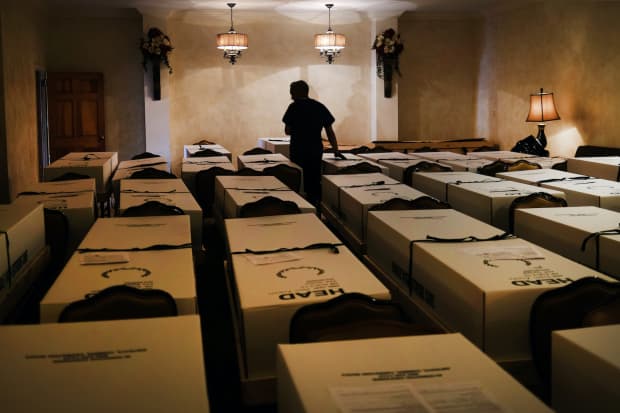This post was originally published on this site

In April, funeral homes in New York City were overwhelmed by the number of dead needing funeral services because of the virus.
Getty Images
No one needs to be told about the carnage. Not in New York City. Not this far in. We all know plenty by now about what this pandemic is capable of and what it has already done.
The 259,005 reported coronavirus infections. The 59,277 in-patient hospitalizations. The 24,047 COVID-19 deaths. And counting. You always have to say “and counting” whenever you try to quantify the wreckage left by this horrible disease. And don’t forget the grieving families, the long-term medical effects, the overwhelmed health-care system, the economic destruction, the depressing lockdowns and the cold-weather wave that’s only beginning to crash in now.
But still.
Despite that lengthy roster of medical mayhem, we still know very little about the virus’s earliest days in New York, where it had a greater impact than at any other place on earth. New Yorkers did an admirable job of bending the curve and beating down the infection rate, literally going from worst to first. But those hard-won successes in the late-spring and early-summer came after some brutal misses in February and March.
At last, we are learning a whole lot more about what happened then.
For this, we can thank researchers at the Icahn School of Medicine at Mount Sinai and a Dutch-born molecular biologist named Harm Van Bakel. He and his team of research scientists live in a world of genome architecture, transcription regulation and coding- and non-coding RNA biology. But since February, they’ve been holed up in a bustling lab on upper Madison Avenue, quietly gathering evidence like homicide detectives on the trail of an especially crafty killer.
Which, come to think of it, is pretty much what they are.
Van Bakel’s team collected 10,000 plasma samples from urgent-care centers, doctors offices and hospital nursing stations across New York. The scientists performed what they call a seroprevalence analysis.
Here’s what they found: The virus that causes COVID-19, known as SARS-CoV-2, had already sunk its claws into New York weeks before the city’s first case was confirmed on the last day of February. People were going about their business—riding the subways, mixing with others in offices and schools, packing into theaters, restaurants and churches—entirely oblivious to the highly infectious virus that was just beginning to take hold. In fact, more than 1.7 million New Yorkers—about 20% of the city’s population—would soon be infected in those early days, far more than anybody realized. And the infection-fatality rate was nearly 1%, 10 times deadlier than the flu.
It started slowly, like epidemics do. But the infections shot up the week ending March 8. The big hike in deaths hit the week ending March 15. Gov. Andrew Cuomo implemented a statewide stay-at-home order March 22. And it wasn’t until April and May that the daily case numbers in the city started to level off and slowly decline.
That period, right in there, is when we were at our most ignorant and our most vulnerable.
“In the initial days and the initial weeks of the pandemic, when the virus arrived in New York, the testing capacity really wasn’t where it needed to be, right?” Van Bakel said in an interview from his lab at week’s end. “It took some time to ramp up the test capacity. And by the time the test capacity was available, we saw massive increases in cases very quickly.”
And the proof was in those plasma samples.
“The first seropositive cases were picked up several weeks earlier than the first confirmed case in New York, which was on Feb. 29 in the Sinai Health system,” he said. “The genetics also showed that the virus was probably already in the city for several weeks prior to this big peak in cases.”
Coronavirus update: U.S. new cases jump 20% to record 121,200 in a single day; ‘We North Dakotans are in crisis,’ says doctor
And New York, like the rest of the world, was nowhere near prepared. How could we have been?
“It’s been on the radar for some time as something that could happen,” Van Bakel said. “But it’s almost unprecedented. We have to go back 100 years to the 1918 pandemic to get a virus that spread with a similar sort of ferocity.”
And what can we do to make sure it doesn’t happen again?
“As soon as we become aware of a potential pandemic virus,” the researcher said, “we have to ramp up test capacity very, very quickly. That cannot just be in one centralized location. It has to be everywhere.”
And one other thing, he said. We’re not close to done, and neither are they.
“The time window that is covered in this study is approximately six months,” he said. “We intend to continue for at least another year. There is still the question of what’s going to happen in the winter. We’ve had a mild uptick in cases in New York City. We still don’t know: How bad is that going to be?”
Ellis Henican is an author based in New York City and a former newspaper columnist.

